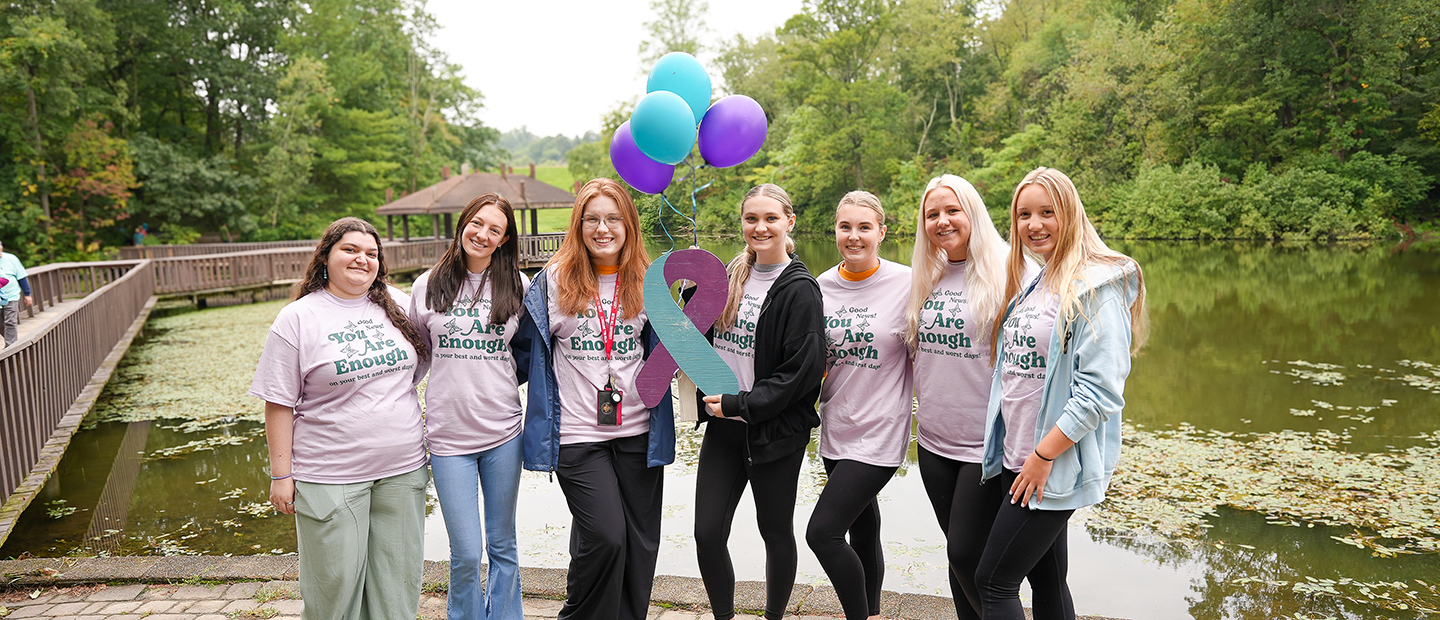Human Anatomy & Physiology Professors Implement New Lab Tech That Increases Student Engagement & Content Retention
by Chelsianna Havko, freelance writer
Interactive lab manuals, slides annotated in real time, iPad devices that allow students to work together as a team—technology in the science labs at Seton Hill has come a long way in a short period of time.
Top Hat, VoiceThread & the Flipped Classroom
Beginning in Fall 2021, the Human Anatomy and Physiology lab classes started using a new electronic lab manual that has dramatically changed the way students learn and engage in classroom discussion.
This program, called Top Hat, allows professors to directly edit content in their lab manuals and then share it with students instantaneously. The customizable approach of Top Hat ensures that content is applicable and relevant to each specific classroom. Professors can add in content that they feel is missing, embed videos, create assignments for the course, and delete any extraneous information the course doesn’t cover.
 “Students don’t have to sift through what is important and what isn’t since we have customized the content to our course,” said Donna Haworth-Ward, Ph.D., assistant professor of biology. “They know that if it is there, they are responsible for it.”
“Students don’t have to sift through what is important and what isn’t since we have customized the content to our course,” said Donna Haworth-Ward, Ph.D., assistant professor of biology. “They know that if it is there, they are responsible for it.”
“It is super advantageous to have all of your materials in one location, for easy accessibility,” added Instructor Kimberly Graziano. “As a learner, everything is directly in front of you; there is minimal flipping from one resource to another. However, all of the “extra” material (from the original text) is still available to the students for their reference at any time. This material is located in a different folder to avoid any confusion for the student.”
Before class begins, students are introduced to the lesson of the day through VoiceThread, a collaborative presentation tool that allows users to add audio, video and written comments to slides. VoiceThread is embedded in Top Hat and students can directly answer review questions right on the platform. In this flipped lab approach, students are already familiar with the content before setting foot in the lab. This means faculty spend less class time on lectures and more time on application-based review.
“This approach has increased student engagement during the review process, therefore increasing content retention,” Dr. Haworth-Ward said. “The students actively participate in identifying structures and we can talk about functions and muddy points that may come up. Student participation has increased dramatically and this allows me to gauge what students are struggling with.”
iPad & Apple Pencil
During class time, Apple iPad devices allow professors to present the slides students have already reviewed in Top Hat. The slides are an abbreviated, unlabelled version of the ones on Top Hat that are out of order so students actively annotate the slides with their professor in real time. The slides, with the annotated notes that students help contribute to, are then uploaded to the platform so students can access them after class and further review on their own time.
“I feel that the use of technology within the labs has elevated them to a new level of learning,” said senior Sidney Kakabar. “We are better able to interact with the information, and gain a deeper understanding of the information. This technology has also enabled a greater sense of student learning, as we now have access to all of the learning material outside of the classroom.”
"As technology evolves, so must we. Being able to integrate it into our lives in a way that is beneficial to us, as shown in the college classroom, is a skill that will become increasingly necessary."
iPad devices are also a central learning tool in the classroom. Each of the four-person lab tables has an iPad and an Apple Pencil for students to collaborate on assignments, such as recording data from experiments, labeling figures, working through pathways and completing coloring activities. Students can work as a group on these assignments and then submit their work together. At first, professors worried that the online text wouldn’t allow students to highlight, take notes, and draw pictures in the text. The iPad and Apple Pencil have essentially eliminated this concern.
“Using the iPad and other technologies, such as Top Hat, have been a great learning tool for students to check comprehension as well as collaborate with each other,” said physician assistant major Olivia Bannon. “The iPad is a great way to collaborate with your lab group and hear different perspectives that may help you to grasp the information better. Overall the technology has really expanded the classroom and brought many opportunities for success in anatomy!”
“The iPad devices that we use in class are very helpful in visualizing the processes that occur in the human body,” agreed Monisola Adigun, who is also studying to become a physician assistant. “We are able to trace pathways and label diagrams easily using an iPad.”
Putting it All Together
In order to implement the new technology most effectively, professors had regular virtual meetings with the university’s Morton and Top Hat representatives. Top Hat worked with professors consistently for eight months from the conception of the idea to the implementation of it that fall semester. It took roughly three months for the platform to be up and running in the classrooms, with professors regularly attending training, onboarding and troubleshooting programs through the summer of 2021. After the fall semester, the anatomy professors asked their students to complete a poll so they could improve the program for Spring 2022.
“We have put an immense amount of time and effort into switching over to Top Hat, but I sincerely feel that it was worth every second,” Dr. Haworth-Ward said. “I also love that we can continue to modify and change the course easily on the platform as we continue to improve our students’ experience.”
Dr. Haworth-Ward continued, “I believe that technology can contribute immensely to education if used appropriately. There are amazing resources available through apps and websites that can exponentially expand the resources available to an instructor to create a more interactive classroom experience at a fraction of the cost of physical models. However, I do believe that while apps and virtual resources are beneficial, they still need to be balanced with in-person physical models to make the connection between a screen and real life.”
Student Success
Students are excited about how the understanding of this kind of technology will be applicable in their future careers.
“As a future physician, most of my notes and logging will take place via technology and synchronized databases,” Kakabar said. “Additionally, there will be much information shared between health care professionals and other health databases by the usage of this integrated technology. By using this in the lab, it has enabled me to gain a greater understanding of how this technology can be used in the healthcare setting, and it has also sharpened my skills regarding this technology.”
Bannon echoed those sentiments, saying, “I feel that technology will be a considerable aspect in my future career in the medical field. Starting with the simple use of it in the classroom will help me down the line in advancing within the field. As technology evolves, so must we. Being able to integrate it into our lives in a way that is beneficial to us, as shown in the college classroom, is a skill that will become increasingly necessary.”
The use of the iPad and other technology in the science labs is just one example of how Seton Hill continues to grow as an Apple Distinguished School. In 2010, Seton Hill became the first university in the world to give all full-time students and professors an Apple iPad. Since then, the university has continued to provide incoming students with Apple devices.
“I think that being an Apple Distinguished School sets our students up for success,” said Dr. Haworth-Ward, who had never used a MacBook before she started teaching at Seton Hill. Now she says she will never go back to PC.
“In addition to learning how to efficiently utilize powerful technology, students have the ability to share information easily. By being part of an Apple Distinguished School, students are gaining technology skills that will help to set them apart from others through their normal daily student activities.”
Next Steps
Based on the success of Top Hat in the laboratory courses, the science professors have decided to expand its use into the lecture component of Anatomy and Physiology courses as well. This will allow professors to incorporate “stop and think” type questions throughout their presentations that students can respond to in real time. Professors will then be able to better gauge understanding as they cover material. Instead of drawing on a whiteboard, professors plan to annotate the slides directly on the Top Hat platform so students can take the drawing with them and use it to study after class. Or, if they do use the whiteboard, professors can easily take a picture and drop it into the Top Hat presentation.
“As an ‘older’ instructor at the University, I will admit that technology is a little more challenging for me,” said Instructor Graziano. “But I feel that the benefits of the online text far outweigh the disadvantages. A strong education is provided by a balance and variety of learning tools, and this technology has allowed us to do just that.”
Photo, right: Professors Haworth-Ward and Graziano with their iPad devices.



